
Healthcare company Baxter International (NYSE: BAX) beat Wall Street’s revenue expectations in Q4 CY2024, but sales were flat year on year at $2.75 billion. On the other hand, next quarter’s revenue guidance of $2.58 billion was less impressive, coming in 1.4% below analysts’ estimates. Its non-GAAP profit of $1.89 per share was significantly above analysts’ consensus estimates.
Is now the time to buy Baxter? Find out by accessing our full research report, it’s free.
Baxter (BAX) Q4 CY2024 Highlights:
- Revenue: $2.75 billion vs analyst estimates of $2.66 billion (flat year on year, 3.4% beat)
- Adjusted EPS: $1.89 vs analyst estimates of $0.52 (significant beat)
- Adjusted Operating Income: $419 million vs analyst estimates of $397.2 million (15.2% margin, 5.5% beat)
- Revenue Guidance for Q1 CY2025 is $2.58 billion at the midpoint, below analyst estimates of $2.61 billion
- Adjusted EPS guidance for the upcoming financial year 2025 is $2.50 at the midpoint, beating analyst estimates by 1.6%
- Operating Margin: -15.8%, down from 11.1% in the same quarter last year
- Constant Currency Revenue rose 2% year on year (5% in the same quarter last year)
- Market Capitalization: $15.74 billion
“Our 2024 performance and related strategic milestones reflect Baxter’s growing momentum in our pursuit of enhanced value for patients, healthcare providers, customers and shareholders,” said Brent Shafer, chair and interim chief executive officer.
Company Overview
Founded in 1931, Baxter International (NYSE: BAX) develops, manufactures, and sells a range of medical products and therapies, focusing on critical care, renal care, hospital products, and advanced surgical solutions.
Medical Devices & Supplies - Diversified
The medical devices industry operates a business model that balances steady demand with significant investments in innovation and regulatory compliance. The industry benefits from recurring revenue streams tied to consumables, maintenance services, and incremental upgrades to the latest technologies. However, the capital-intensive nature of product development, coupled with lengthy regulatory pathways and the need for clinical validation, can weigh on profitability and timelines. In addition, there are constant pricing pressures from healthcare systems and insurers maximizing cost efficiency. Over the next several years, one tailwind is demographic–aging populations means rising chronic disease rates that drive greater demand for medical interventions and monitoring solutions. Advances in digital health, such as remote patient monitoring and smart devices, are also expected to unlock new demand by shortening upgrade cycles. On the other hand, the industry faces headwinds from pricing and reimbursement pressures as healthcare providers increasingly adopt value-based care models. Additionally, the integration of cybersecurity for connected devices adds further risk and complexity for device manufacturers.
Sales Growth
A company’s long-term sales performance signals its overall quality. Even a bad business can shine for one or two quarters, but a top-tier one grows for years. Baxter struggled to consistently generate demand over the last five years as its sales dropped at a 1.3% annual rate. This fell short of our benchmarks and is a sign of poor business quality.
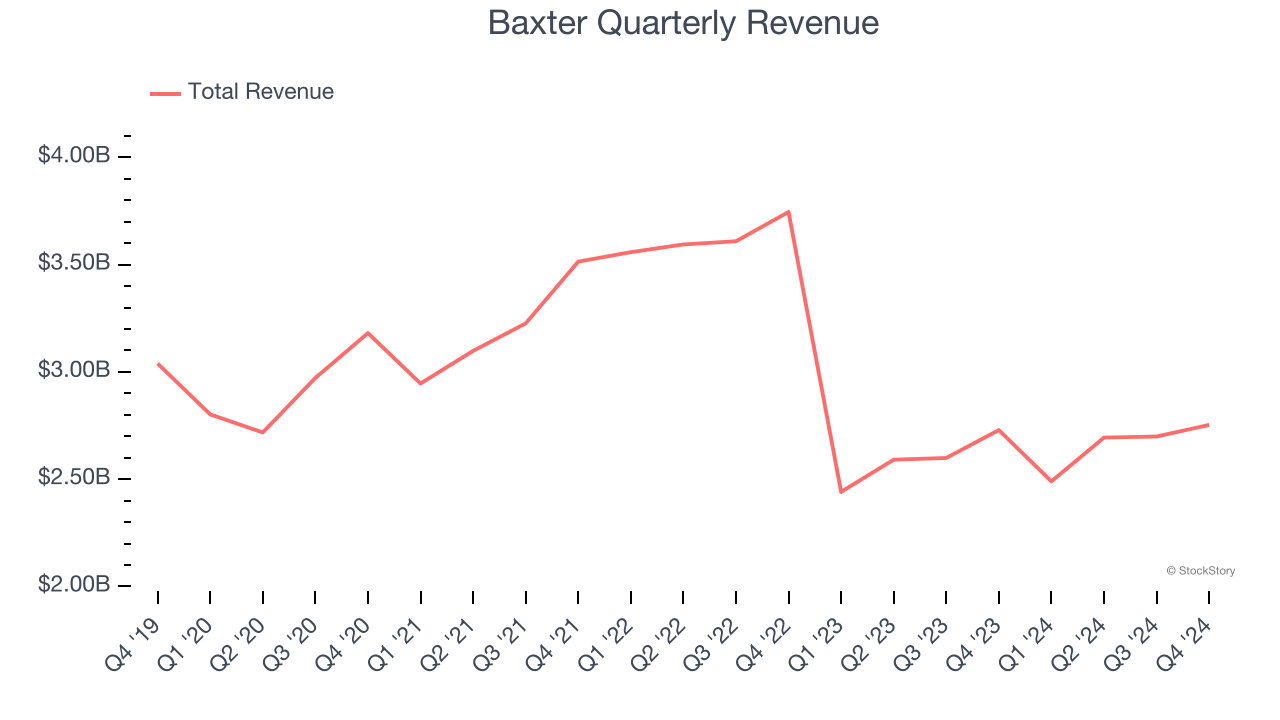
We at StockStory place the most emphasis on long-term growth, but within healthcare, a half-decade historical view may miss recent innovations or disruptive industry trends. Baxter’s recent history shows its demand has stayed suppressed as its revenue has declined by 14.4% annually over the last two years. 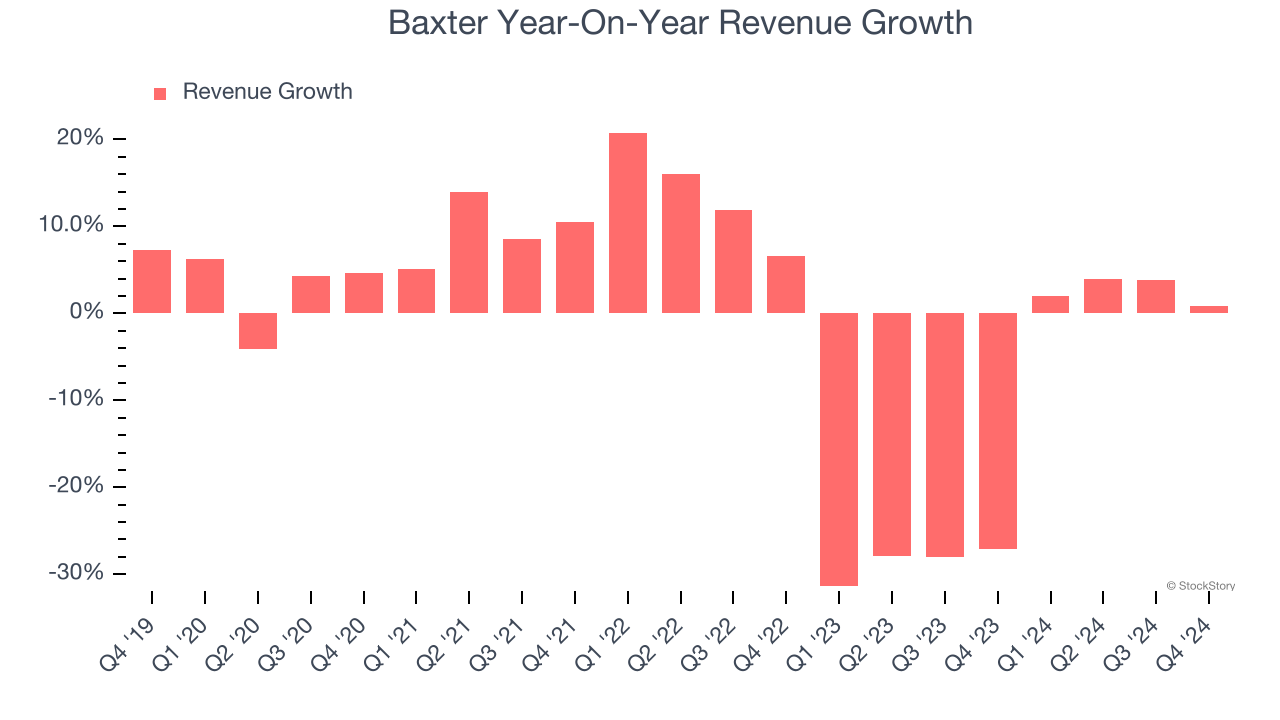
We can better understand the company’s sales dynamics by analyzing its constant currency revenue, which excludes currency movements that are outside their control and not indicative of demand. Over the last two years, its constant currency sales averaged 3.4% year-on-year growth. Because this number is better than its normal revenue growth, we can see that foreign exchange rates have been a headwind for Baxter. 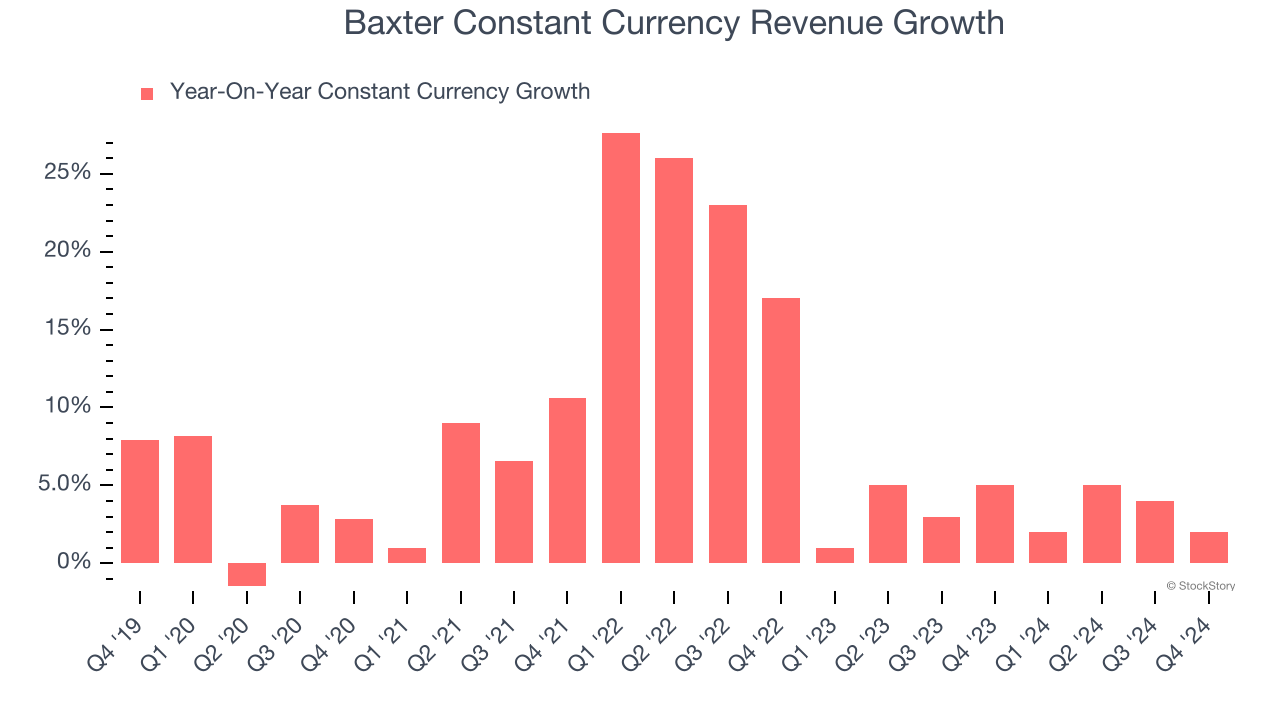
This quarter, Baxter’s $2.75 billion of revenue was flat year on year but beat Wall Street’s estimates by 3.4%. Company management is currently guiding for a 3.5% year-on-year increase in sales next quarter.
Looking further ahead, sell-side analysts expect revenue to grow 5.1% over the next 12 months, an improvement versus the last two years. This projection is above average for the sector and suggests its newer products and services will spur better top-line performance.
Today’s young investors won’t have read the timeless lessons in Gorilla Game: Picking Winners In High Technology because it was written more than 20 years ago when Microsoft and Apple were first establishing their supremacy. But if we apply the same principles, then enterprise software stocks leveraging their own generative AI capabilities may well be the Gorillas of the future. So, in that spirit, we are excited to present our Special Free Report on a profitable, fast-growing enterprise software stock that is already riding the automation wave and looking to catch the generative AI next.
Adjusted Operating Margin
Adjusted operating margin is an important measure of profitability as it shows the portion of revenue left after accounting for all core expenses – everything from the cost of goods sold to advertising and wages. It’s also useful for comparing profitability across companies because it excludes non-recurring expenses, interest on debt, and taxes.
Baxter has managed its cost base well over the last five years. It demonstrated solid profitability for a healthcare business, producing an average adjusted operating margin of 16.3%.
Looking at the trend in its profitability, Baxter’s adjusted operating margin decreased by 4.1 percentage points over the last five years. The company’s two-year trajectory also shows it failed to get its profitability back to the peak as its margin fell by 1.8 percentage points. This performance was poor no matter how you look at it - it shows its expenses were rising and it couldn’t pass those costs onto its customers.
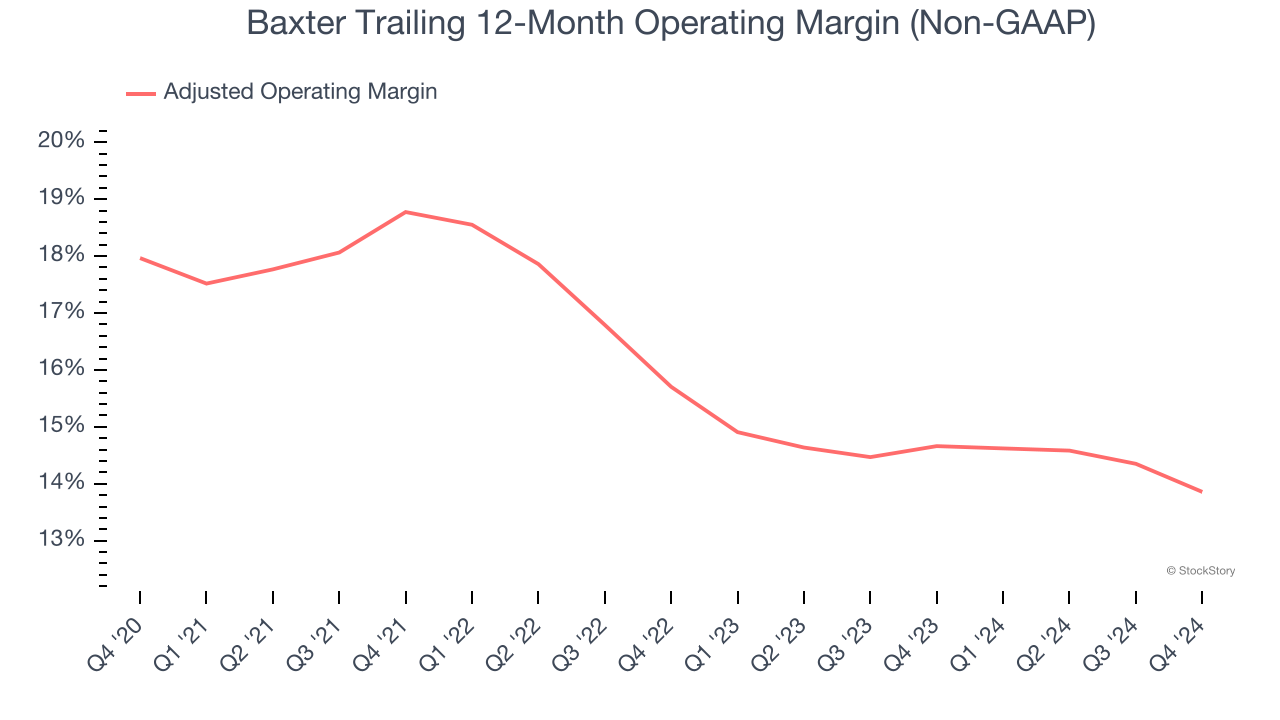
In Q4, Baxter generated an adjusted operating profit margin of 15.2%, down 1.9 percentage points year on year. This reduction is quite minuscule and indicates the company’s overall cost structure has been relatively stable.
Earnings Per Share
We track the long-term change in earnings per share (EPS) for the same reason as long-term revenue growth. Compared to revenue, however, EPS highlights whether a company’s growth is profitable.
Baxter’s flat EPS over the last five years was weak but better than its 1.3% annualized revenue declines. However, we take this with a grain of salt because its adjusted operating margin didn’t expand and it didn’t repurchase its shares, meaning the delta came from reduced interest expenses or taxes.
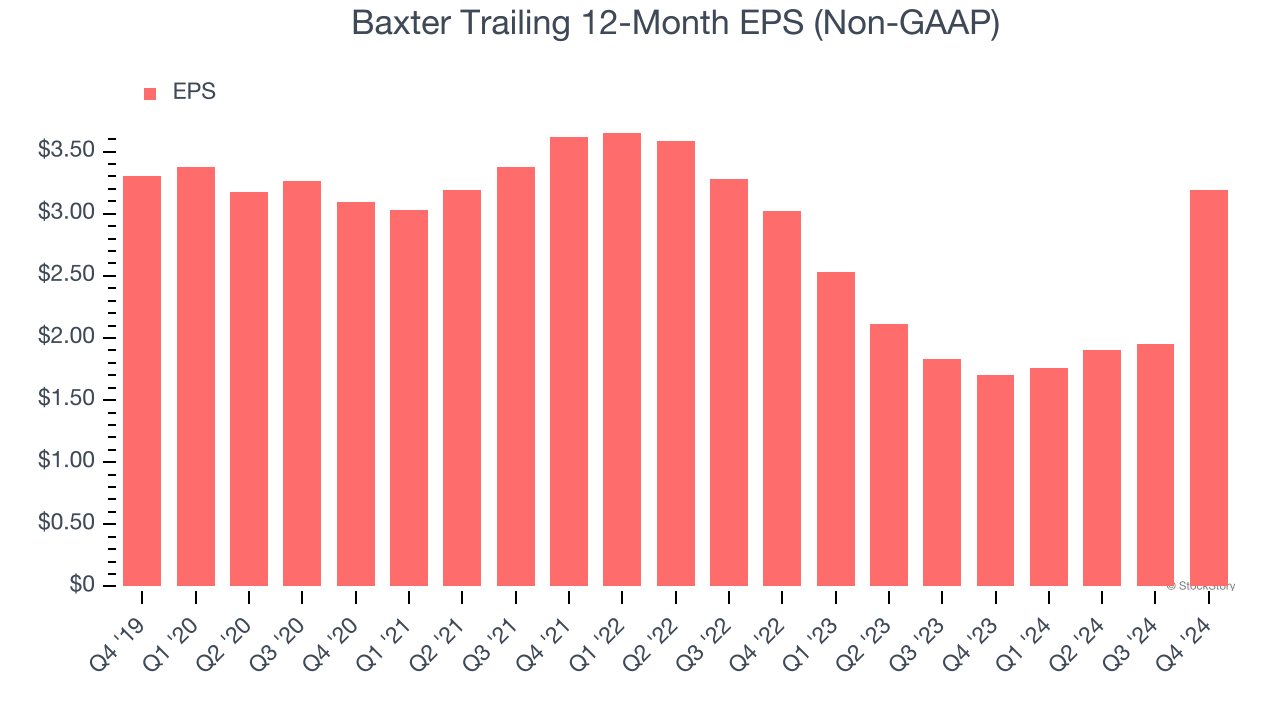
In Q4, Baxter reported EPS at $1.89, up from $0.65 in the same quarter last year. This print easily cleared analysts’ estimates, and shareholders should be content with the results. Over the next 12 months, Wall Street expects Baxter’s full-year EPS of $3.19 to shrink by 21.9%.
Key Takeaways from Baxter’s Q4 Results
We were impressed by how significantly Baxter blew past analysts’ constant currency revenue expectations this quarter. We were also excited its EPS outperformed Wall Street’s estimates by a wide margin. Looking ahead, full-year EPS guidance came in ahead of expectations. This was a good quarter, and the stock traded up 7.4% to $33.11 immediately after reporting.
Baxter had an encouraging quarter, but one earnings result doesn’t necessarily make the stock a buy. Let’s see if this is a good investment. We think that the latest quarter is only one piece of the longer-term business quality puzzle. Quality, when combined with valuation, can help determine if the stock is a buy. We cover that in our actionable full research report which you can read here, it’s free.





